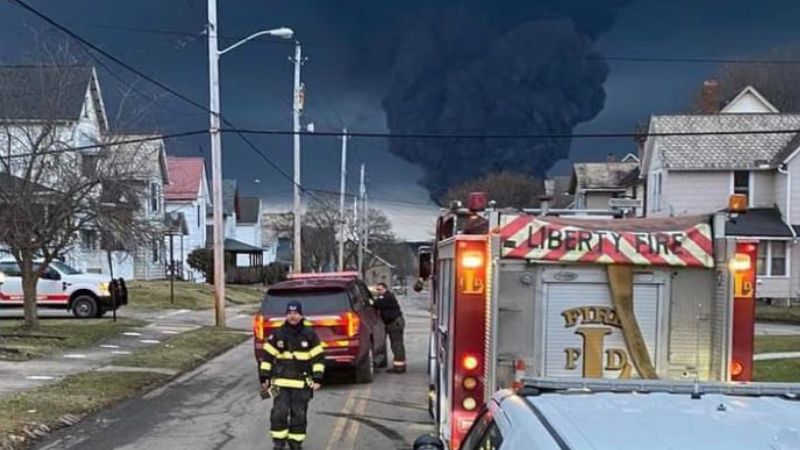Ohio Derailment: The Extended Impact Of Lingering Toxic Chemicals On Buildings

Table of Contents
Assessing the Scope of Chemical Contamination
The Ohio derailment released a cocktail of hazardous chemicals, including vinyl chloride, butyl acrylate, and ethylene glycol monobutyl ether. These substances can react differently with various building materials, causing significant long-term damage. Brick, wood, metal, and even concrete are susceptible to degradation depending on the specific chemical and its concentration. Vinyl chloride, for instance, can degrade certain plastics and potentially leach into building materials over time. Butyl acrylate, known for its corrosive properties, can damage metal components and accelerate the deterioration of wood.
The invisible nature of many of these chemicals presents a significant challenge in assessing the extent of contamination. Simply looking at a building doesn't reveal the unseen damage. Thorough and comprehensive testing is essential to understand the full scope of the problem.
- Examples of specific chemical reactions and their impact on building integrity: Vinyl chloride can weaken plastic pipes and window frames, while butyl acrylate can corrode metal ductwork and roofing materials. Exposure to these chemicals can also compromise the structural integrity of building materials over time, leading to future safety hazards.
- Methods used for assessing contamination levels: Soil testing, air quality monitoring, and material analysis are crucial methods. These tests can determine the presence and concentration of toxic chemicals in the soil surrounding buildings, the air inside buildings, and the building materials themselves.
- Difficulties in accessing all affected areas for comprehensive testing: The sheer scale of the affected area and the complexities of accessing all affected properties create logistical hurdles in conducting thorough and complete testing.
Long-Term Health Risks Associated with Contaminated Buildings
Prolonged exposure to residual chemicals within contaminated buildings poses significant health risks. Inhalation of airborne contaminants can lead to respiratory problems, while skin contact can cause irritation and other dermatological issues. Some of the released chemicals are known carcinogens, increasing the risk of long-term health complications. The invisible nature of many of the contaminants makes regular monitoring and early detection challenging.
- Specific health problems linked to exposure to the released chemicals: Respiratory illnesses, skin irritation, headaches, nausea, and potentially long-term health issues like cancer are all possible consequences of exposure.
- Symptoms to watch out for in residents of affected buildings: Residents should monitor themselves and family members for any respiratory difficulties, unexplained rashes, persistent headaches, or other unusual symptoms.
- Recommendations for mitigating health risks: Using high-quality air purifiers with HEPA filters, regular thorough cleaning with appropriate cleaning agents, and avoiding contact with potentially contaminated surfaces are essential precautions. Professional air quality testing is highly recommended.
The Economic Impact on Affected Properties
The Ohio derailment's toxic chemical contamination significantly devalues affected properties. Selling or insuring contaminated buildings becomes exceedingly difficult, as buyers and insurance companies are understandably hesitant to take on the financial and legal risks associated with such properties. The costs associated with remediation are substantial, adding further economic strain on homeowners and businesses. Legal battles over liability and compensation could stretch on for years.
- Economic implications for homeowners and businesses: Significant reductions in property value, increased insurance premiums (if insurance is even available), and the substantial costs of remediation create significant financial burdens.
- Potential legal avenues for compensation: Homeowners and businesses may have legal recourse to seek compensation for damages and losses incurred due to the contamination. Consulting with legal professionals specializing in environmental law is essential.
- The role of insurance companies in addressing the damage: Insurance companies may deny claims citing pre-existing conditions or exclusions related to environmental contamination. Legal action may be necessary to secure compensation from insurance providers.
Remediation and Decontamination Strategies
Decontaminating buildings affected by the Ohio derailment involves a complex and multi-faceted approach. Methods range from air scrubbing and surface cleaning to, in some cases, complete demolition. The choice of remediation strategy depends on the extent and nature of the contamination, as well as the type of building materials involved. The process is expensive and time-consuming, demanding rigorous safety protocols to protect workers and the surrounding environment.
- Specific decontamination techniques: Air scrubbing systems remove airborne contaminants, while surface cleaning utilizes specialized techniques and cleaning agents to remove chemical residues. In severely contaminated cases, demolition and removal of affected materials may be necessary.
- The role of environmental agencies in overseeing remediation efforts: Government agencies play a crucial role in overseeing the remediation process, ensuring that it is conducted safely and effectively according to strict environmental regulations.
- Long-term monitoring to ensure the effectiveness of remediation: After remediation is complete, ongoing monitoring is essential to verify the effectiveness of decontamination efforts and to ensure that the area remains safe.
Conclusion: Understanding the Long-Term Impact of the Ohio Derailment on Buildings
The Ohio derailment's impact on buildings extends far beyond the immediate aftermath. The lingering threat of toxic chemical contamination presents significant long-term health and economic consequences. Comprehensive assessment, effective remediation, and ongoing monitoring are essential to ensuring the safety and value of affected properties. Residents and businesses must stay informed about ongoing developments and seek professional advice if they suspect their property has been affected by the lingering toxic chemicals from the Ohio derailment. Contact your local environmental agency or the Ohio EPA for information on testing and remediation resources. Understanding the long-term effects of this disaster is critical for the future health and prosperity of the affected communities. Do not hesitate to seek professional help if you are concerned about toxic chemical contamination affecting your building's safety. Learn more about the Ohio derailment cleanup and your rights regarding property assessment.

Featured Posts
-
 Analysis Red Sox Lineup Changes Following Outfielders Return And Casas Demotion
Apr 28, 2025
Analysis Red Sox Lineup Changes Following Outfielders Return And Casas Demotion
Apr 28, 2025 -
 Pirates Win Walk Off Thriller Against Yankees In Extras
Apr 28, 2025
Pirates Win Walk Off Thriller Against Yankees In Extras
Apr 28, 2025 -
 Jetour Dashing Tampil Dengan Tiga Pilihan Warna Baru Di Iims 2025
Apr 28, 2025
Jetour Dashing Tampil Dengan Tiga Pilihan Warna Baru Di Iims 2025
Apr 28, 2025 -
 Buehler Starts For Red Sox Full Lineups Against Blue Jays Revealed
Apr 28, 2025
Buehler Starts For Red Sox Full Lineups Against Blue Jays Revealed
Apr 28, 2025 -
 Aaron Judge And Paul Goldschmidt Power Yankees To Series Salvaging Win
Apr 28, 2025
Aaron Judge And Paul Goldschmidt Power Yankees To Series Salvaging Win
Apr 28, 2025
Latest Posts
-
 New York Yankees Aaron Judge Becomes A Father
Apr 28, 2025
New York Yankees Aaron Judge Becomes A Father
Apr 28, 2025 -
 Aaron Judge And Wife Welcome First Child
Apr 28, 2025
Aaron Judge And Wife Welcome First Child
Apr 28, 2025 -
 Espns Moving Tribute To Departing Anchor Cassidy Hubbarth
Apr 28, 2025
Espns Moving Tribute To Departing Anchor Cassidy Hubbarth
Apr 28, 2025 -
 Cassidy Hubbarths Final Espn Broadcast A Touching Tribute
Apr 28, 2025
Cassidy Hubbarths Final Espn Broadcast A Touching Tribute
Apr 28, 2025 -
 Emotional Goodbye Espn Bids Farewell To Cassidy Hubbarth
Apr 28, 2025
Emotional Goodbye Espn Bids Farewell To Cassidy Hubbarth
Apr 28, 2025
